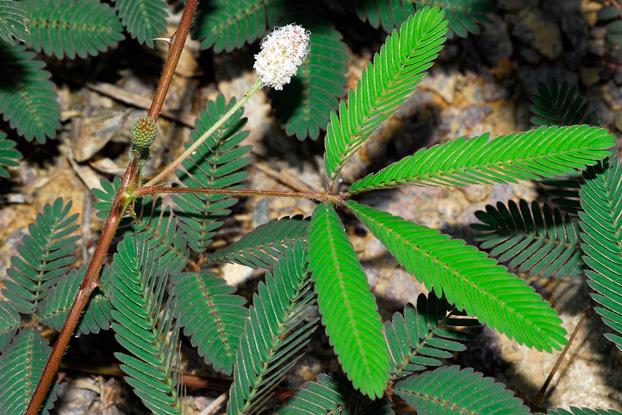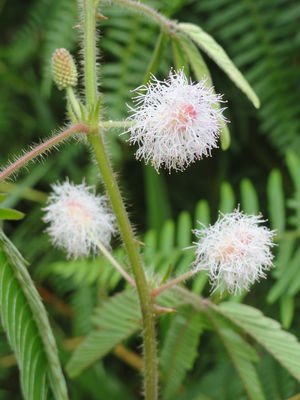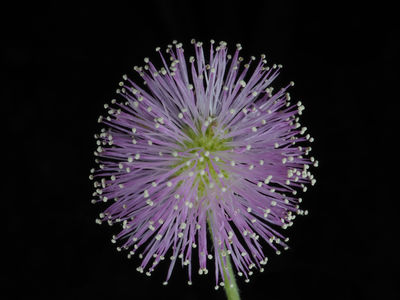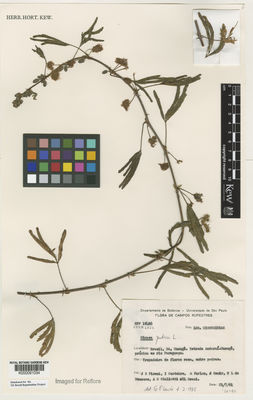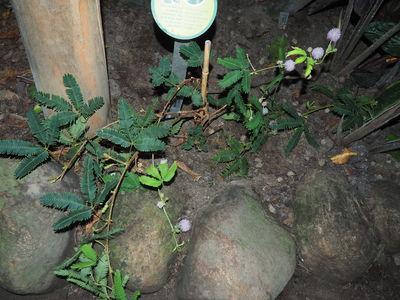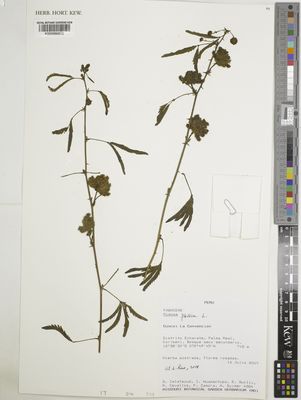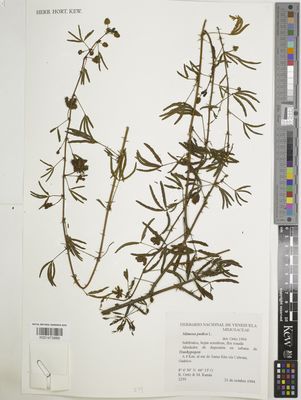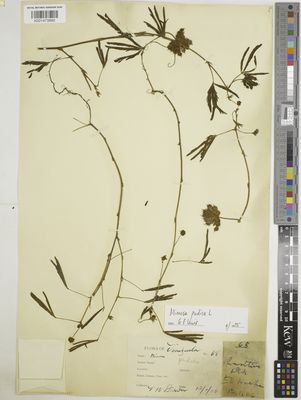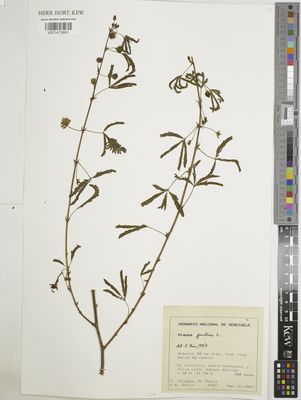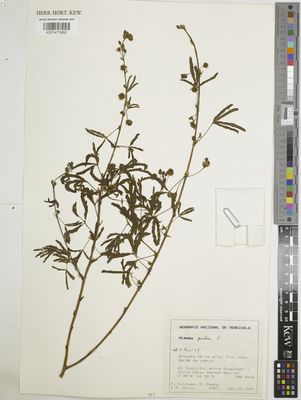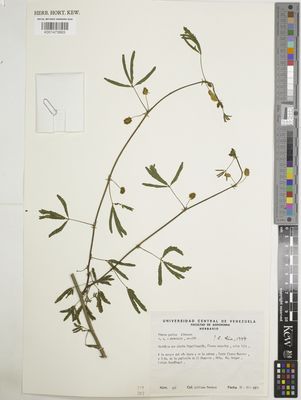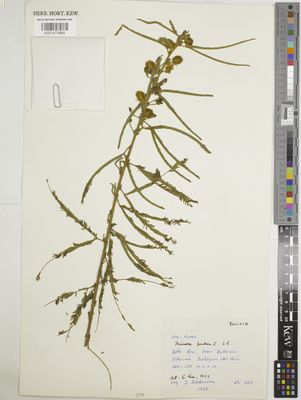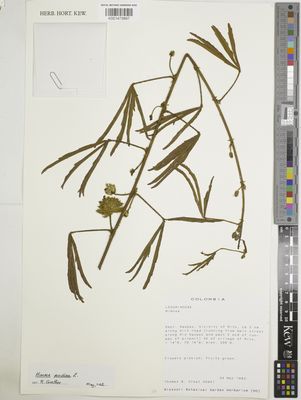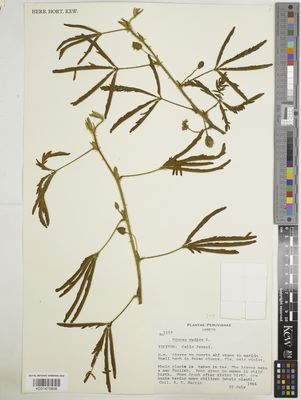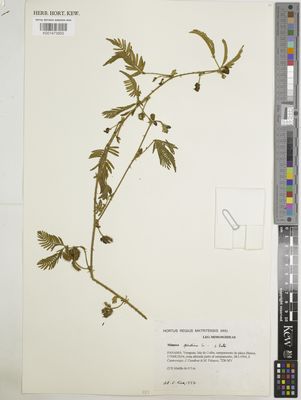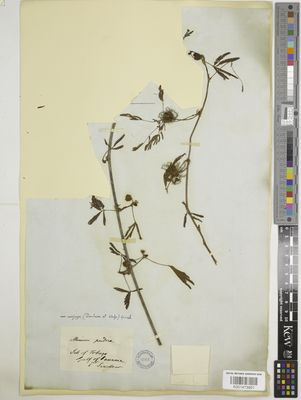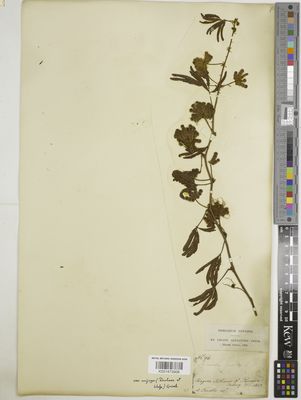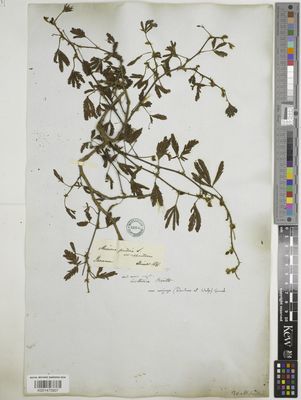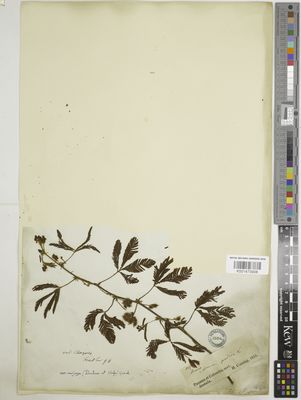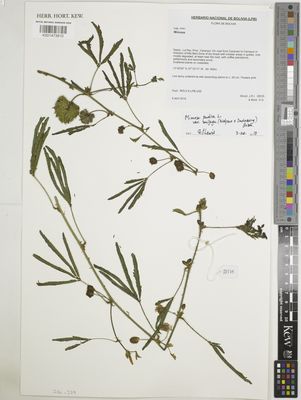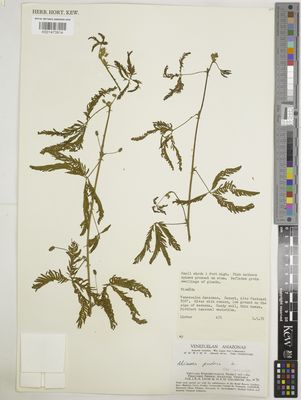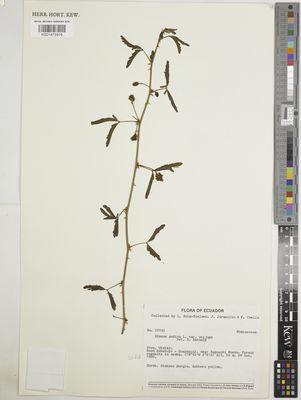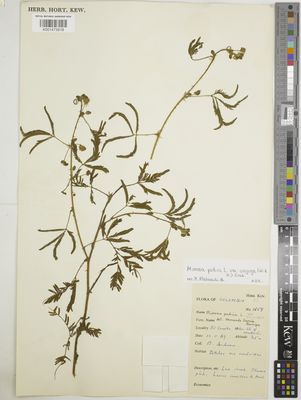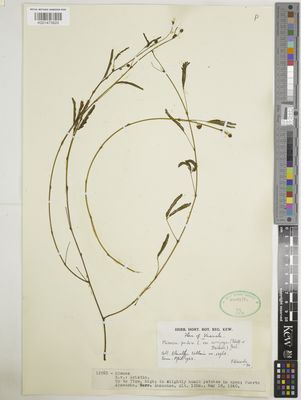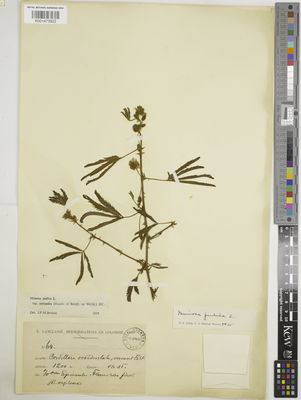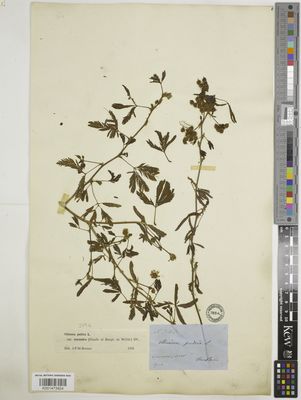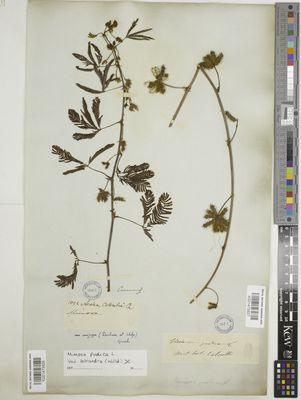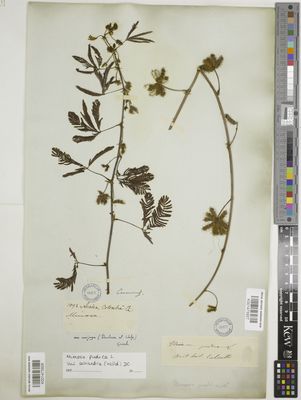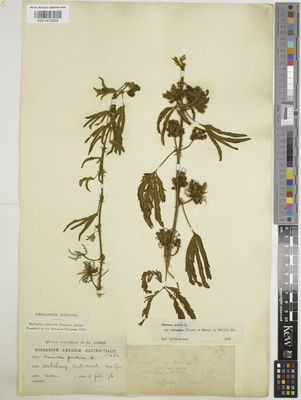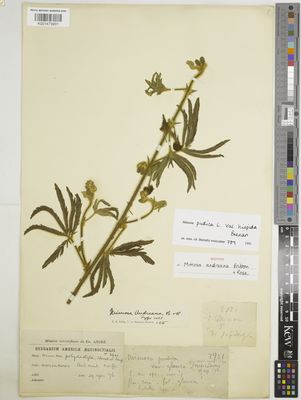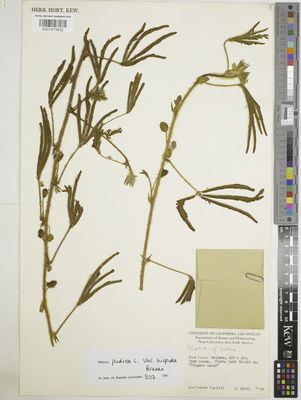Geography and distribution
Sensitive plant is native to tropical America, and is found as a weed throughout the tropics. It also enjoys widespread popularity as a house plant.
Description
Overview: An annual or perennial that normally grows to 50-70 cm tall (but can be up to 1 m tall), and often takes the form of a straggling prickly sub-shrub. Its stems have sparse prickles, 2-2.5 mm long, or are sometimes bristly, or can also be almost hairless.
Leaves: The leaves are alternate, bipinnate (twice compound), do not have prickles and are very sensitive to touch. The rachis (axis of the compound leaf) is 1.5-5.5 cm long, and the pinnae (primary divisions of the compound leaf) are subdigitate (almost finger-like projections). There are 10-26 pairs of leaflets (the smallest segments of the leaf) per pinna, which are 6-15 x 1.2-3 mm and linear-oblong.
Flowers: The flowers are lilac or pink (the colour mainly the stamen filaments) and are held in ovoid, stalked heads of 1-1.3 x 0.6-1 cm. A cluster of 1-5 flower heads is borne in the leaf axil. The calyx is minute, about 0.2 mm long. The corolla is 2-2.3 mm long, and contains four stamens.
Fruits: The pods are 1.8 cm x 3-5 mm, densely bristly, clustered, and have prickles along their margins.
Like many other legumes, the sensitive plant benefits from an association with nitrogen-fixing bacteria, which live within its root nodules. These bacteria convert atmospheric nitrogen into a form which the plant can make use of, and which aids its growth.
Rupert C. Barneby (accomplished legume taxonomist, 1911-2000) recognised five varieties of M. pudica . These varieties ( M. pudica var hispida , var. pastoris , var. pudica , var. tetranda and var. unijuga ) are found up to 1,500 m above sea level, and are distinguished from each other using aspects of the flowers and plant indumentum (hairs).
What's in a name?
Mimosa pudica was described by Carl Linnaeus (Swedish botanist and father of modern taxonomy, 1707-1778), and is the type species for the genus. The generic name Mimosa is derived from the Greek mimos (meaning mimic) in reference to the fact that the leaves move in response to something moving against them. The specific epithet is taken from the Latin word pudica , meaning bashful or shrinking to contact. The type material for M. pudica is from Brazil and is sterile (does not include any flowers or fruits). It forms part of the historical George Clifford Herbarium at the Natural History Museum, London. George Clifford was an Anglo-Dutch merchant (1685-1760) who owned an estate on which Carl Linnaeus worked from 1735 to 1737.
More common names for this species
sensitive plant, touch-me-not plant, humble plant, shameful plant (English); amourette herbe, herbe sensible, sensitive, sensitive épineus, mimosa pudique (French); vergonsoza, dormidera, ten vergüenza (Spanish); pinahuixtle, quecupatli (Nahuatl, Mexico); mori vivi (Hispaniola); honte (Haiti); dormideira (Brazil, Portuguese); Chui-Mui (Urdu); Lojjaboti (Bengali); hánxiū cǎo = shyness grass (Chinese); Nidi kumba (Sri Lanka).
Legumes and plant movement
Mimosa pudica is not the only member of the legume plant family (Leguminosae) to move in response to stimuli. More species of Mimosa show sensitivity to touch, known as seismonasty. Other legumes, for example some members of the genera Neptunia , Acacia , Albizia and Samanea , respond to a lesser degree by showing 'sleep movements' (nyctinasty) in their natural habitats. This involves the closing up of the leaves a few hours before dusk, and the re-opening of the leaves a few hours before dawn. It is thought that these 'sleep movements' aid water conservation as well as defence against herbivory.
Threats and conservation
The sensitive plant is widely distributed in the tropics, and is not considered to be threatened. Indeed, it is included in the Global Invasive Species Database as one of the world's worst invasive weeds, invading forestry plantations, croplands, orchards and pastures throughout the tropics, especially in South Asia, the Pacific Islands and some African countries. It can be especially problematic when crops are hand-cultivated, as it has prickles along its stems. Measures have been taken to eradicate it in some areas, for example in Queensland, Australia.
Uses
Traditional medicine
Mimosa pudica has been used widely in traditional medicine. Pulped leaves are used in India on glandular swellings and in the Republic of the Congo (Congo-Brazzaville) the entire plant is pulped and rubbed onto people suffering pains in their body sides and kidneys. In Senegal, the leaves are used for lumbago and nephritis. All parts of the plant have been used to combat glandular tumours and uterine cancer. In India leaf-sap is applied for sinus disorders, and rubbed onto sores and piles.
In southeast Asia sensitive plant has been used traditionally to treat sleep disorders, and in Senegal an infusion of the leaves is believed to be calming and sleep-inducing. M. pudica has also been used for treating dysentery, urinary complaints and snake-bites. Root extracts have shown anti-bacterial action, and along with the seeds are purgative and emetic. However, high doses can be toxic. There are reports that the roots can be used as an aphrodisiac. Green parts of the plant are used as an analgesic, antispasmodic, anti-asthmatic, a mild sedative and anti-depressant. Despite its wide use in traditional medicine, M. pudica is not yet used in Western medicine, as pharmaceutical companies are still researching its reported properties and potential uses.
Other uses
Sensitive plant is used as a green manure, and cultivated as pasture in Fiji.
In India it is used as forage for cattle, and is considered to lead to high meat and milk production. Regular grazing is necessary so that thorny stems do not develop. Despite its use as forage, trials in India and Hawaii have shown it can be toxic if fed in high quantities to cattle or horses.
M. pudica is also used in some areas as ground cover to prevent soil erosion.
Sensitive plant produces mucilage (a viscous secretion) and a greenish-yellow fatty acid. The oil contains linoleic acid (51%), oleic acid (31%), palmitic and stearic acids (9% each), and traces of others; it resembles soy bean oil, potentially having similar uses.
Millennium Seed Bank: Seed storage
The Millennium Seed Bank Partnership aims to save plant life worldwide, focusing on plants under threat and those of most use in the future. Seeds are dried, packaged and stored at a sub-zero temperature in our seed bank vault.
Collections of Mimosa pudica seeds are held in Kew's Millennium Seed Bank based at Wakehurst in West Sussex.
See Kew's Seed Information Database for further information on Mimosa pudica seeds
Cultivation
Sensitive plant is propagated from seed in Kew's Tropical Nursery. The seed is scarified (scratched) and soaked in water overnight. The seed germinates easily, and it is often possible to see the beginnings of root growth by the next day. The compost mix used is high in organic matter, containing 10% loam, 45% coir and 45% Silvafibre, with added fertiliser.
The sensitive plant suffers from pests including red spider mite, thrips and mealy bugs. Soap sprays are not used to control pests as they cause the leaves to blacken (this is the case with many legumes).
Mimosa seeds are widely available, inexpensive and can be sown indoors all year round. Seedlings should be kept moist and exposed to bright light, and at a temperature of about 18°C. M. pudica var. hispida , which originates from southwest Mexico, is the most popularly cultivated variety.
Where to see the sensitive plant at Kew
Sensitive plant can be seen growing in Kew's Waterlily House. It is also grown behind-the-scenes in Kew's Tropical Nursery.
Kew's Economic Botany Collection includes samples of the leaves, stems and seeds of Mimosa pudica .

